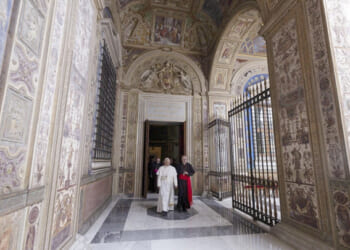There was a moment in American cultural history when a single individual’s sense of beauty became a civic responsibility. Personal taste, quietly yet firmly expressed through private collections, once shaped public institutions. Today, when committees rather than collectors primarily determine museum acquisitions, it’s worth reflecting on what has been lost and why it might matter.
Henry Clay Frick, J. P. Morgan, and Henry E. Huntington were collectors whose names still evoke a powerful sense of personal vision. Their legacy remains tangible in the institutions bearing their names, which arose not from consensus or collective judgment but from singular discernment. They were neither democratic nor egalitarian. Their methods were exclusive, particular, even idiosyncratic. Yet from these private judgments emerged collections that continue to enrich the public imagination.
Frick’s mansion on Fifth Avenue is an embodiment of the magnate’s deliberate, refined taste. Its galleries are meticulously curated, each room presenting a distinct narrative shaped by the sensibility of one man. His collection was assembled not simply for personal enjoyment but also for posterity. His eye gravitated toward harmony and solemnity: Vermeer, Titian, Rembrandt—works that bore the weight of inheritance and moral seriousness. He avoided the novel or sensational, preferring paintings that maintained continuity with the European past and had the dignity of restraint.
The Frick Collection stands as a rare example of coherence, guided by individual conviction rather than committee consensus. Visitors experience more than just art. They encounter the presence of Frick himself, his character and judgment preserved within each acquisition.
Similarly, J. P. Morgan’s library at Thirty-sixth and Madison speaks to his profound understanding of cultural stewardship. Morgan collected rare manuscripts, illuminated texts, and priceless artworks, driven by intellectual curiosity and aesthetic discernment. His acquisitions were not dictated by popularity, nor were they diluted by compromise. Morgan’s taste was encyclopedic, bordering on imperial: Babylonian tablets, Renaissance bindings, Egyptian antiquities—all collected with a sense that civilization’s memory must be physically preserved. His library was not just a repository but a bastion against cultural forgetting.
Morgan’s judgment was rigorous, unyielding, and fiercely independent. Today, the Morgan Library & Museum remains a monument not only to the objects it contains but to the distinctive vision that guided its creation. It invites visitors to engage deeply with history, culture, and beauty, undistracted by the pressures of modern institutional politics.
Henry Huntington’s contribution is equally instructive. His gardens, galleries, and libraries in Southern California embody a similar philosophy: personal taste as public trust. Huntington’s estate was meticulously crafted, each piece selected with intention. He understood that the public benefit of his private collection was precisely its reflection of cultivated sensibility. Where Frick leaned understated and Morgan expansive, Huntington sought synthesis. His taste united landscape, literature, and portraiture, with Gainsborough beside rare folios and gardens behind Italian sculpture, suggesting a vision of refinement rooted in serenity rather than scale.
Huntington’s legacy persists because he refused to yield to fashion or fleeting trends, instead favoring depth, quality, and enduring significance.
These collectors shared certain traits: immense wealth, yes, but also intellectual ambition, moral seriousness, and confidence in their tastes. They saw themselves not merely as private collectors but also as custodians of culture. Their acquisitions were neither random nor ostentatious; rather, they embodied considered judgments intended to outlast their own lifetimes.
Contrast this legacy with contemporary museum practices. Today’s institutions are heavily influenced by broad committees, guided by diversity mandates and financial strategies designed to minimize risk. This modern approach introduces distinct trade-offs. Museums today often lack a cohesive vision, their collections a mosaic assembled by way of compromise.
The emphasis on collective decision-making has produced institutions increasingly hesitant to take aesthetic risks or express strong judgments. In the pursuit of inclusivity and institutional neutrality, museums often lose the powerful coherence that comes from single, authoritative vision. While contemporary methods may foster broader participation, they dilute the unified narratives that defined earlier collections.
This evolution reflects broader societal trends. Modern donors frequently choose anonymity or donor-advised funds, creating transactional relationships with culture rather than memorable legacies. Philanthropy advising has shifted toward immediacy, measurable impact, and short-term objectives. The ambition to shape public taste, a hallmark of earlier generations, is now rare.
Moreover, public suspicion toward individual judgment has grown. The very notion of “taste” is often treated skeptically, equated with elitism or exclusivity. Yet taste, properly understood, involves discernment and courage. It is inherently selective, requiring the willingness to make choices and stand behind them.
This loss of cultural confidence has consequences. Institutions become less distinctive, more homogenized, and less capable of offering transformative experiences. Without the guidance of individuals willing to commit to particular aesthetic principles, museums risk becoming indistinct, bland reflections of collective compromise rather than vibrant cultural repositories.
It is critical to remember that the gentleman’s bequest was not simply an investment or display of wealth. It represented a deeply personal form of stewardship. Such collectors were conscious of their place in history, aware that their private decisions had public implications. They collected not for personal vanity but out of a sense of civic duty.
Restoring such clarity and confidence to our cultural institutions requires revisiting the spirit of the gentleman’s bequest. Institutions must not merely accept funds but welcome donors who offer coherent, articulated visions. Museums should encourage judgment, risk-taking, and, yes, even controversy. By doing so, they may again foster worthy cultural institutions rather than mere consensus.
The Frick, the Morgan, and the Huntington all stand today as enduring testimony to the power of individual judgment and the value of principled collections. They challenge us to reconsider our suspicion of personal taste in cultural stewardship. They remind us that culture thrives not on timid neutrality but on choices made by confident, discerning individuals.
As our institutions navigate complex societal expectations, they would do well to remember the power of the gentleman’s bequest. In embracing such individual discrimination, we affirm not merely the enduring value of cultural legacy, but also our belief in the power of personal judgment. The gentleman’s bequest is a model that insists culture is too important, too precious, to leave entirely to committees. It is a call to rediscover the courage, clarity, and conviction that built the institutions we cherish.

















